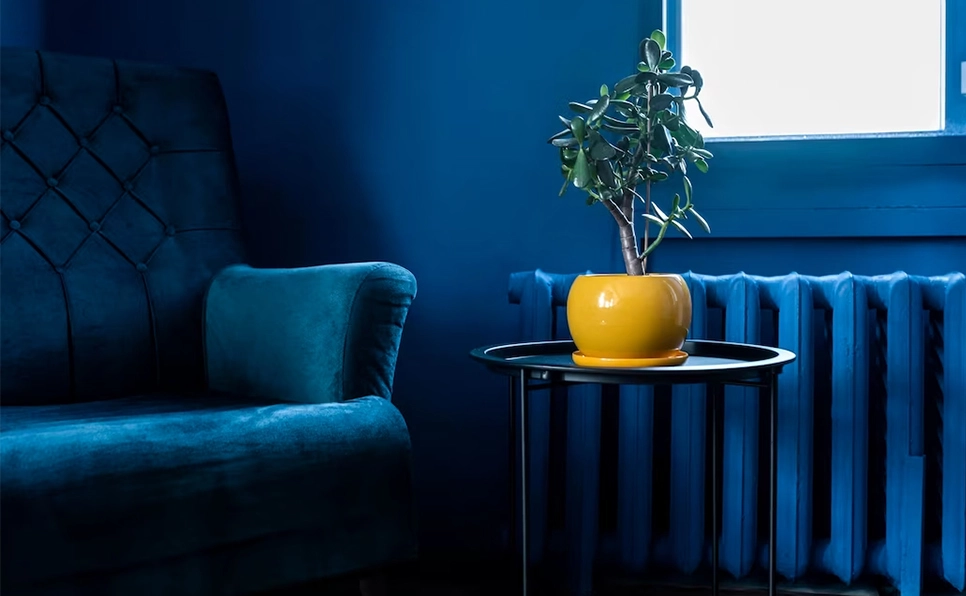If you’re looking to revamp your living space with a touch of style, comfort, and energy with contemporary furniture designs, then you’ll want to pay attention to the latest design trends for 2023. We consulted professional designers and industry experts to get their take on what’s hot and what’s not in interior design. While some trends like blue hues, personality-packed rugs, statement window treatments, and marble slabs in kitchens are timeless and were also popular in 2022, other trends such as plaster walls, high-gloss wood finishes, and fully equipped craft rooms may come as a surprise.
So, get ready to embrace the latest interior design trends to add a modern and chic touch to your space.
Keeping up with design trends is important because it ensures that your home or workspace reflects current styles and feels fresh and modern. Additionally, keeping up with design trends can add value to your property and help you create a cohesive and well-designed space.
We are to explore the top 10 contemporary furniture design trends in 2023 and provide practical advice on how to incorporate them into your home or workspace.
This will aid in having a better understanding of the latest furniture design trends and how to incorporate them into your space to create a modern and stylish atmosphere.
Top 10 trending contemporary furniture designs
1. Micro luxury
Micro luxury refers to the concept of creating luxurious and high-end living spaces in small and compact areas. It involves maximizing the functionality and aesthetic appeal of limited space while maintaining a lavish and sophisticated feel.
Examples of micro luxury spaces include studio apartments, tiny homes, and other compact living spaces that incorporate high-end finishes, elegant decor, and modern amenities. These spaces are designed to offer residents a comfortable and luxurious lifestyle, despite their limited square footage.
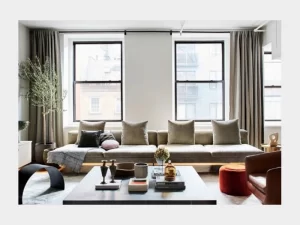
One of the primary benefits of micro luxury living is the ability to enjoy a luxurious and high-end lifestyle without the high cost of a larger home or apartment.
To create a micro luxury living space, consider using high-quality finishes and materials, such as marble countertops, hardwood flooring, and designer lighting fixtures. Incorporate smart storage solutions, such as built-in cabinets and shelves, to keep clutter to a minimum. Utilize multi-functional furniture, such as a sofa bed or a fold-out dining table, to maximize space and create a more versatile living environment.
2. Muted colors
Muted colors refer to colors that have been toned down or de-saturated, creating a softer and more subtle look than their brighter counterparts. They are colors that have been mixed with gray, black or white to reduce their intensity.
Examples of muted colors include dusty pink, sage green, muted blue, and grayish lavender. These colors are often used in interior design to create a calming and relaxing atmosphere, and they can be paired with bolder accents to create a sophisticated look.
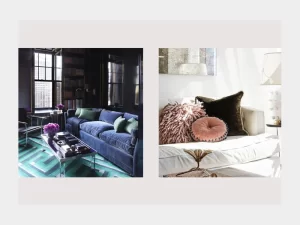
One of the primary benefits of using muted colors in interior design is their ability to create a calming and relaxing environment. They are also versatile and can be used in a variety of design styles, from traditional to modern.
Integrating muted colors into your interior design, consider using them as a base color for walls, furniture, or accent pieces. Pair muted colors with bolder accents, such as bright throw pillows or bold artwork, to create a balanced and visually appealing look. Utilize texture and pattern to add depth and interest to the space, and consider incorporating natural materials, such as wood or stone, to create a sense of warmth and coziness.
3. Statement lamps
Statement lamps refer to lighting fixtures that are designed to be a focal point in a room. They often feature bold or unique designs and can be used to add personality and visual interest to a space.
Examples of statement lamps include oversized floor lamps, sculptural table lamps, and pendant lights with intricate designs. These design-based lamps can be made from a variety of materials, such as metal, glass, or fabric, and can be used to complement or contrast with the overall design aesthetic of a space.
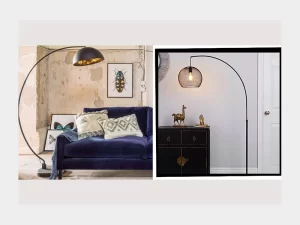
One of the primary benefits of using statement lamps in interior design is their ability to add visual interest and personality to a space. They can be used to create a focal point in a room or to draw attention to specific features, such as artwork or architectural details.
Adding statement lamps into your interior design, consider using them as a focal point in a room. Place an oversized floor lamp in a corner to create a cozy reading nook or use a sculptural table lamp to add visual interest to a console table.
4. High-tech features
High-tech features in interior design refer to the integration of advanced technology into various aspects of a living space, such as lighting, security systems, entertainment systems, and home automation.
Some of the examples include smart lighting systems that can be controlled through voice commands or a mobile app, smart thermostats that adjust the temperature based on occupancy and outside weather conditions, home security systems with remote access and monitoring, and entertainment systems that can be easily integrated with smart devices.
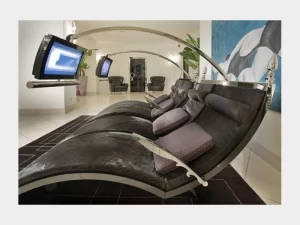
One of the primary benefits of high-tech features in interior design is increased convenience and efficiency. Smart technology allows for easy control and automation of various aspects of a living space, from lighting to temperature to security. This can lead to a more comfortable and seamless living experience for residents.
To incorporate high-tech features into interior design, consider using smart lighting systems, smart thermostats, and smart home security systems. Incorporate voice-controlled assistants like Amazon Alexa or Google Assistant to enable hands-free control of various features. Integrate entertainment systems with smart devices, such as smart TVs or wireless sound systems.
5. Geometric shapes
Geometric shapes refer to the use of basic shapes such as triangles, circles, squares, and rectangles in interior design. The shapes can be used in a variety of ways to create a modern and sophisticated look.
The use of hexagonal tiles in a bathroom, a pendant light fixture with a geometric shape, and a geometric-patterned area rug are a few examples of geometric shaped contemporary furniture design ideas in interior design. Other examples include geometric-shaped mirrors, wall art, and furniture pieces such as a triangular-shaped bookshelf.
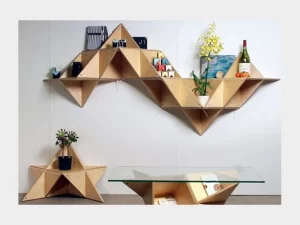
Using geometric shapes in interior design can add visual interest and depth to a space. They can also create a modern and sophisticated look that is both timeless and on-trend.
To incorporate geometric shapes into interior design, consider using them in a variety of ways. For example, you could use geometric-shaped tiles on a backsplash in the kitchen or bathroom or incorporate geometric patterned wallpaper on an accent wall. You could also add geometric-shaped decor, such as vases or candle holders, or use geometric-shaped light fixtures to add visual interest to a room.
6. Arches
Arches are curved structural elements that have been used in architecture for centuries. In interior design, arches are often used as decorative features to add interest and elegance to a space.
Examples of arches in interior design include curved doorways, arched windows, and curved walls or ceilings. Arches can be made of various materials such as wood, stone, or plaster and can range in size and shape from a subtle curve to a grand, sweeping archway.
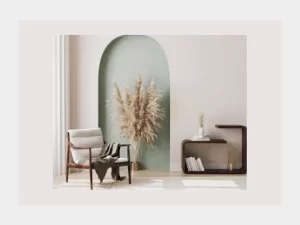
Arches can add a sense of grandeur and architectural interest to a space, particularly in homes or buildings with a historical or classical design style. They can also serve as a visual divider between different areas of a room or create a focal point for a space.
To incorporate arches into an interior design, consider adding a curved doorway between rooms or creating an arched alcove for a cozy reading nook. Arched windows can add a unique and elegant touch to a space while also allowing for natural light. Curved walls or ceilings can add visual interest to a room and can be used to create a sense of flow and movement throughout a space.
7. Multi-functional pieces
Multifunctional pieces refer to furniture or home accessories that serve more than one purpose. These pieces are designed to maximize space and functionality while maintaining an aesthetically pleasing and cohesive design.
Sofa beds, storage ottomans, coffee tables with built-in storage, modular shelving units, and convertible dining tables are some of the examples of multifunctional pieces. These pieces are designed to serve multiple purposes, such as providing storage, serving as extra seating, or transforming into a bed for guests.
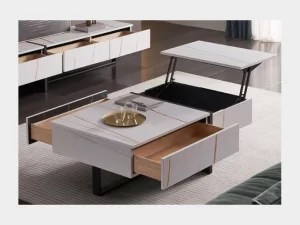
One of the primary benefits of multifunctional pieces is the ability to maximize space and functionality in a home or living area. These pieces allow homeowners to make the most of limited square footage, without sacrificing style or comfort.
To incorporate multifunctional pieces into a home design, consider using modular furniture that can be rearranged or reconfigured as needed. Look for furniture with built-in storage or hidden compartments, such as a bed with under-bed storage or a coffee table with a lift-top for storage. Consider using convertible furniture, such as a dining table that can be folded down or extended as needed, or a sofa that can be converted into a bed for guests.
8. Statement rugs
Statement rugs refer to large, eye-catching rugs that serve as a focal point in a room. They often feature bold colors, intricate patterns, or unusual textures, and can be used to add visual interest and personality to a space.
Examples of statement rugs include colorful Persian rugs, graphic geometric patterns, and fluffy shag rugs. These rugs can be used in any room of the house, from the living room to the bedroom, and can be paired with a variety of furniture styles and color schemes.
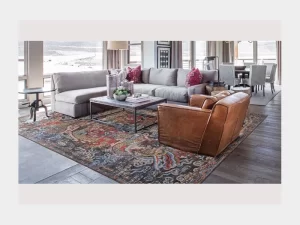
One of the primary benefits of statement rugs is their ability to instantly transform a space and add personality and visual interest. They can also be used to tie together different design elements in a room, such as coordinating with throw pillows or artwork.
When incorporating a contemporary furniture design statement rug into a space, consider using it as the starting point for the rest of the room’s design. Use the colors and patterns in the rug as inspiration for coordinating throw pillows, curtains, or other decor elements. Alternatively, use a bold rug to add a pop of color to a more neutral space.
9. Handcrafted pieces
Handcrafted pieces refer to decor and furniture items that are made by hand rather than mass-produced through automated processes. They are created using traditional techniques, such as weaving, pottery, or woodworking, and often incorporate natural materials and unique designs.
Handwoven baskets, ceramic vases, wooden furniture, and textiles with hand-embroidered designs are some of the well-known examples of handcrafted pieces. These items are often one-of-a-kind or made in small batches and can add a unique and personal touch to any living space.
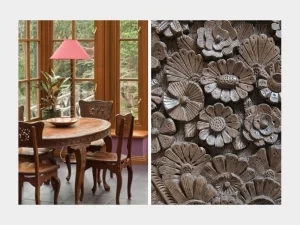
One of the primary benefits of handcrafted pieces is their uniqueness and character. Because they are made by hand, each item is slightly different and can add a sense of authenticity and warmth to a space.
To incorporate handcrafted pieces into a design, consider using them as statement pieces in a room. For example, a handwoven rug or a large ceramic vase can serve as a focal point in a living room or dining area. Mixing and matching different types of handcrafted items can also create an eclectic and personalized look.
10. Plaid
Plaid is a pattern consisting of crisscrossed horizontal and vertical bands in multiple colors. It is a versatile pattern that can be incorporated into various design styles and can add visual interest to a space.
Plaid can be found in a range of design elements, such as blankets, upholstery fabrics, wallpaper, and rugs. It is often associated with traditional or rustic design styles, but it can also be used in contemporary or modern spaces to add texture and warmth.
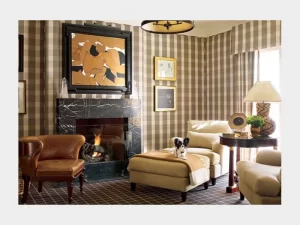
Plaid can bring a cozy and inviting feel to a space, making it perfect for use in living rooms, bedrooms, and other areas where comfort is a priority.
To incorporate plaid into a space, consider using it in small doses, such as in throw pillows or a small accent rug. For a bolder statement, use plaid in larger design elements, such as a statement wall covered in plaid wallpaper or a plaid upholstered chair.
Finalizing the trends of 2023
In conclusion, the top 10 contemporary furniture design trends for 2023 include: micro luxury, muted colors, statement lamps, high-tech features, geometric shapes, arches, multifunctional pieces, statement rugs, handcrafted pieces, and plaid.
To incorporate these trends into your home design, consider using high-quality finishes and materials, incorporating smart storage solutions, utilizing multi-functional furniture, adding luxurious amenities, and incorporating handcrafted or statement pieces to elevate the overall feel of the space.
Keeping up with design trends is important as it can help keep your space feeling fresh and modern. Incorporating new and innovative design elements can also help improve the functionality and overall aesthetic appeal of your home. Remember to choose trends that align with your personal style and preferences to create a space that truly feels like home.

